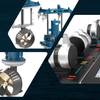Mitsui Orders 2 LNG Carriers from MHI
Mitsubishi Heavy Industries, Ltd. (MHI) reports it has received an order for two next-generation LNG (liquefied natural gas) carriers from Mitsui & Co., Ltd., scheduled for completion and delivery in 2018 and 2019, respectively. They will be put into service for the Cameron LNG Project underway in the United States, an initiative in which Mitsui is participating, marking the first order placed to MHI for LNG carriers to transport shale gas.
The order for the two LNG carriers was received through MI LNG Company, Limited, a joint venture between MHI and Imabari Shipbuilding Co., Ltd. The vessels will be constructed at MHI's Nagasaki Shipyard & Machinery Works.
According to the builder, the carriers’ design improves both LNG carrying capacity and fuel performance through a more efficient hull structure and hybrid propulsion system. Specifications will be LOA (length overall) of 297.5m, width of 48.94m, depth of 27m and draft of 11.5m. The carriers will have four apple-shaped tanks, an improved version of high-reliability Moss-type tanks designed with a bulging upper half. Total holding capacity of the tanks will be 177,000 cubic meters (m3). LNG carrying efficiency has been increased as the vessel width has been kept to a size enabling its passage through the newly expanding Panama Canal expected to go into service early in 2016.
The LNG carriers on order feature a hybrid propulsion system dubbed STaGE (Steam Turbine and Gas Engines), which as its name implies combines a steam turbine and engines that can be fired by gas. STaGE's components consist of the Ultra Steam Turbine plant (UST), a highly efficient reheating steam type marine turbine developed independently by MHI, a dual-fuel diesel engine capable of operating on both gas and oil, and an electric propulsion motor. Plant efficiency has been substantially improved through the UST's effective use of the engine's waste heat, resulting in a propulsion system enabling high-efficiency navigation throughout a full range of speeds.
Demand for LNG as a fuel for generating power has been increasing not only in Japan but worldwide. Simultaneously, LNG produced in North America in tandem with America's "Shale Gas Revolution" is projected to grab an expanding share of the global market going forward, a trend that is resulting in longer LNG transport distances.
Against this backdrop, MHI looks to attract expanding demand for its next-generation LNG carriers offering superlative transport capacity, fuel efficiency and environmental performance. By focusing on securing a position of superiority amid intensifying competition worldwide, the company aims to contribute to both the domestic and global LNG transport industries.
















